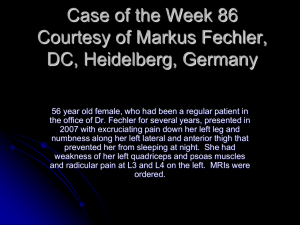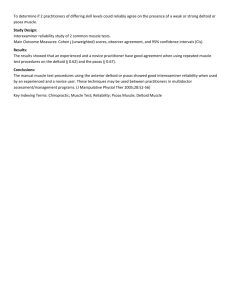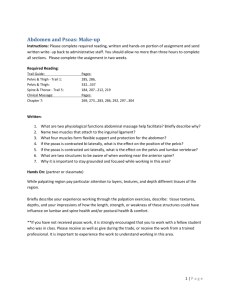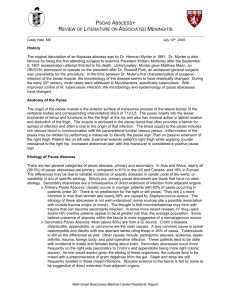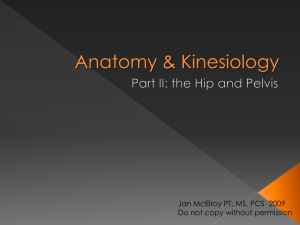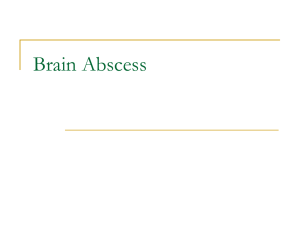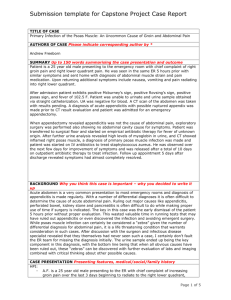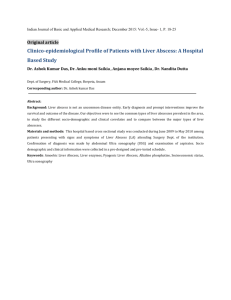Article 4 Differentiation of Psoas Muscle Abscess From Septic
advertisement
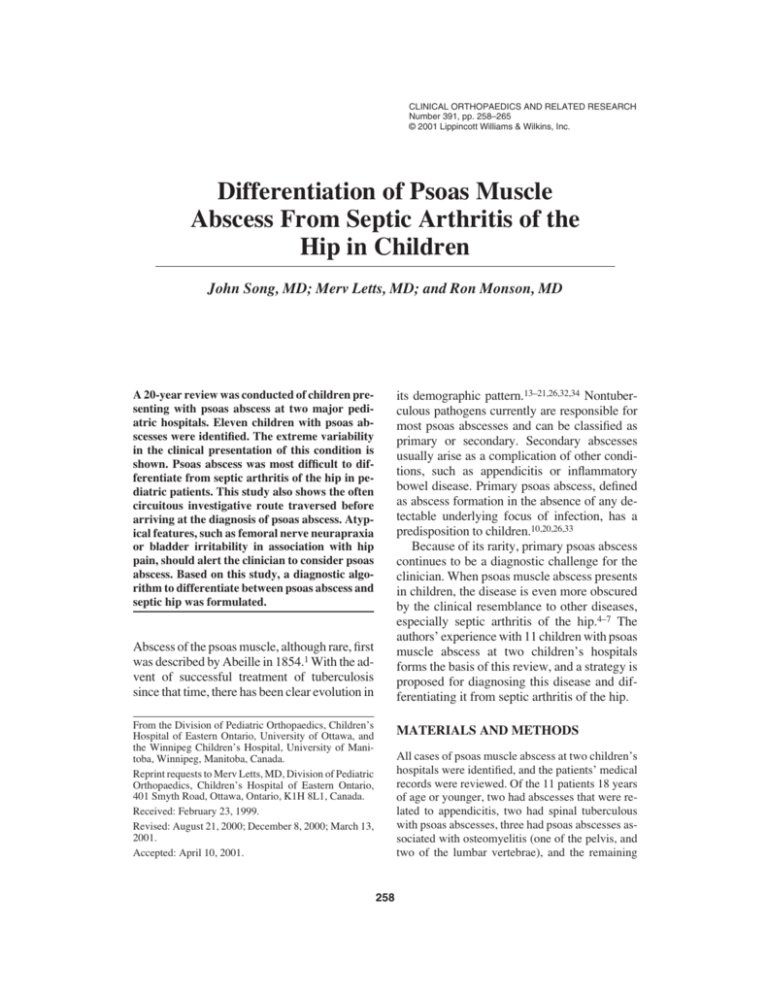
CLINICAL ORTHOPAEDICS AND RELATED RESEARCH Number 391, pp. 258–265 © 2001 Lippincott Williams & Wilkins, Inc. Differentiation of Psoas Muscle Abscess From Septic Arthritis of the Hip in Children John Song, MD; Merv Letts, MD; and Ron Monson, MD its demographic pattern.13–21,26,32,34 Nontuberculous pathogens currently are responsible for most psoas abscesses and can be classified as primary or secondary. Secondary abscesses usually arise as a complication of other conditions, such as appendicitis or inflammatory bowel disease. Primary psoas abscess, defined as abscess formation in the absence of any detectable underlying focus of infection, has a predisposition to children.10,20,26,33 Because of its rarity, primary psoas abscess continues to be a diagnostic challenge for the clinician. When psoas muscle abscess presents in children, the disease is even more obscured by the clinical resemblance to other diseases, especially septic arthritis of the hip.4–7 The authors’ experience with 11 children with psoas muscle abscess at two children’s hospitals forms the basis of this review, and a strategy is proposed for diagnosing this disease and differentiating it from septic arthritis of the hip. A 20-year review was conducted of children presenting with psoas abscess at two major pediatric hospitals. Eleven children with psoas abscesses were identified. The extreme variability in the clinical presentation of this condition is shown. Psoas abscess was most difficult to differentiate from septic arthritis of the hip in pediatric patients. This study also shows the often circuitous investigative route traversed before arriving at the diagnosis of psoas abscess. Atypical features, such as femoral nerve neurapraxia or bladder irritability in association with hip pain, should alert the clinician to consider psoas abscess. Based on this study, a diagnostic algorithm to differentiate between psoas abscess and septic hip was formulated. Abscess of the psoas muscle, although rare, first was described by Abeille in 1854.1 With the advent of successful treatment of tuberculosis since that time, there has been clear evolution in From the Division of Pediatric Orthopaedics, Children’s Hospital of Eastern Ontario, University of Ottawa, and the Winnipeg Children’s Hospital, University of Manitoba, Winnipeg, Manitoba, Canada. Reprint requests to Merv Letts, MD, Division of Pediatric Orthopaedics, Children’s Hospital of Eastern Ontario, 401 Smyth Road, Ottawa, Ontario, K1H 8L1, Canada. Received: February 23, 1999. Revised: August 21, 2000; December 8, 2000; March 13, 2001. Accepted: April 10, 2001. MATERIALS AND METHODS All cases of psoas muscle abscess at two children’s hospitals were identified, and the patients’ medical records were reviewed. Of the 11 patients 18 years of age or younger, two had abscesses that were related to appendicitis, two had spinal tuberculous with psoas abscesses, three had psoas abscesses associated with osteomyelitis (one of the pelvis, and two of the lumbar vertebrae), and the remaining 258 Number 391 October, 2001 TABLE 1. 259 Psoas Muscle Abscess in Children Summary of Published Cases of Psoas Abscess in Children Authors Number of Cases Tong et al30 Golli et al 10 Malhotra et al20 Parbhoo and Govender21 Average Age of Patient (years) Culture Positive for Streptococcus Aureus 4.3 5.4 6.2 2 5 6 16 1 Beta Streptococcus 2 36/69 2 2 4 1 mixed 1 group Beta Streptococcus 3 6 9 24 Chaitow et al6 Bresee and Edwards*5 King et al16 Spiegel et al29 Song et al (current study) 2 104 (96 primary) 3 3 11 (7 primary) 10.6 8.2 9.6 12.6 9.3 *Includes eight cases related to abdominal infections. four patients had no clear source of infection that could be identified. These four children were considered to have primary, nontuberculous psoas abscesses (Table 1). This series was compared with cases of psoas muscle abscess in children reported in the literature to better define the typical symptomatology of this syndrome (Tables 2, 3). CASE REPORT A 17-month-old girl presented to the emergency room after a 2-week history of intermitTABLE 2. tent fever and irritability. A limp had developed, and the patient had hip pain 3 days before admission. Apart from a slow healing abrasion that was present 2 months previously over the patient’s left knee, there was no history of prior illnesses or trauma. At examination, the patient’s temperature was 38C, and her right hip was held in flexion, with extension, internal rotation, and abduction causing severe pain. There were no masses palpable in her abdomen, flank, or groin, although Clinical and Laboratory Results in Psoas Abscess Physical Findings in Psoas Abscess Psoas Sign Fixed Flexion Deformity Hip Flank or Abdominal Pain Palpable Mass Elevated Erythrocyte Elevated Sedimentation Leukocyte Rate Count Authors Limp Tong et al30 Golli et al10 Malhotra et al20 Parbhoo and Govender21 Chaitow et al6 King et al16 Spiegel et al29 Bresee and Edwards*5 Song et al (current study) 3 4 9 24 3 8 10 0 1 11 0 3 3 0 9 11 6 9 24 2 3 3 38/72 0 0 9/69** 2 51/69 1 2 1 13/69 2 1 2 36/69 2 3 3 29/31 2 3 2 29/31 10 11 8 0 4 3 **Seventeen of 69 patients were described as having full, painless hip motion. 0 260 Clinical Orthopaedics and Related Research Song et al TABLE 3. Diagnosis and Treatment of Psoas Abscess Diagnosis by Authors Tong et al30 Golli et al10 Malhotra et al20 Parbhoo and Govender21 Chaitow et al6 Bresee and Edwards*5 King et al16 Spiegel et al29 Song et al (current study) Treatment by CT Scan Ultrasound Incision and Drainage Percutaneous Drainage Only Intravenous Antibiotics 3/3 6/6 0 5/5 2/2 6/6 9/9 19/24 0 3 7 22 2 2 0 0 1 2 2 2 2/2 11/11 0/1 14/15 2 99/107 0 8/107 0 0 2 1 1 MRI (2) 2 1 1 2 0 0 9/9 1/1 6 2 3 the inguinal lymph nodes seemed to be enlarged. The erythrocyte sedimentation rate was 66 mm, and the leukocyte count was elevated at 29,300 per high power field. A radiograph of the pelvis showed a shadow over the right iliac fossa (Fig 1). Intravenous cefazolin and gentamicin were started, and the patient was admitted with a presumptive diagnosis of septic arthritis of the right hip. On the same day, with the patient under general anesthesia, aspiration of the hip with fluoroscopic assistance yielded negative Fig 1. The right sacroiliac joint is obscured by the shadow of a psoas abscess in Patient 1. results. A bone scan was negative for osteomyelitis; however, accumulation of the radionucleotide in the bladder revealed that it was being displaced by a large space-occupying lesion in the right iliac fossa (Fig 2). This was shown by computed tomography (CT) scan to be a large abscess in the psoas muscle Fig 2. The bone scan showed bladder displacement by a large psoas abscess in the right iliac fossa. There is absence of activity in the bony tissue. Number 391 October, 2001 Psoas Muscle Abscess in Children 261 Fig 3. A large psoas abscess can be seen in this CT scan (arrows). (Fig 3). Surgical incision and drainage of a 6 8-cm abscess was done using a retroperitoneal approach, and methicillin-sensitive Staphylococcus aureus grew from the culture specimen. By the third day after surgery, the patient was afebrile; the next day the patient was discharged on a regimen of intravenous cefazolin. After completing 2 weeks of antibiotics, the patient was clinically well and walking without a limp. RESULTS Of 11 children (11 cases) with psoas abscess, two cases were attributable to tuberculous abscess and two cases were from direct spread from a primary appendicitis. Four of the remaining seven cases were primary psoas abscess. The remaining three cases were associated with osteomyelitis of the ilium and vertebral bodies. The average age of a child presenting with psoas abscess was 8 years in patients in this series. A slight predisposition in boys was seen. No predisposition to the infected side was seen. The infecting agent was most commonly Staphylococcus aureus. In the cases of psoas abscess with multiple bacteria cultured, Staphylococcus aureus also was isolated in each instance. The most common clinical findings were limp and pain in the hip. The wide variability of symptoms and signs of a psoas abscess in a child also was seen. This included abdominal pain, thigh pain, back pain, and absence of any hip symptoms reported in 17 of 69 published cases5 (and in two of seven cases in the current series). The psoas sign is attributed to inflammation causing spasm of the psoas muscle. To perform this maneuver, the hip is flexed, relieving tension in the psoas muscle, which then allows painless internal or external motion of the hip. In a positive test, the patient’s pain will be aggravated with extension of the hip and relieved in flexion. This test was not useful in any of the current patients. More commonly, the hip had pseudoparalysis and a fixed flexion deformity. This may be inaccurate reporting, but in the current series, the authors were unable to show any passive motion of the hip without causing severe discomfort in four of the children. The sedimentation rate and leukocyte count were elevated in all of the patients in the current study and in more than 98% of patients reported in the literature. Preceding infection within 1 month was reported in approximately 1 ⁄3 of all patients in both the curent study and those reported in the literature. (Table 2) The most common misdiagnosis was septic arthritis of the hip. Usually this resulted in an 262 Clinical Orthopaedics and Related Research Song et al Fig 4. An algorithm for differentiation between psoas abscess and septic arthritis of the hip is shown. aspiration or arthrotomy of the hip. The most effective imaging studies that were used most frequently were ultrasound and CT (Fig 4), which were equally effective in revealing the diagnosis. Both have been used to guide percutaneous drainage. The other commonly used study, the plain film radiograph, seldom was useful although often informative in retrospect. Treatment of the psoas abscess most frequently required incision and drainage and administration of intravenous antibiotics. With the recent capability of interventional radiology, percutaneous drainage is becoming more common with equally good results. One of the patients with a large psoas abscess had drainage of the abscess using ultrasound guidance. In two of the patients, only intravenous antibiotics were used for treatment of small psoas abscesses. The duration of intravenous antibiotic coverage was variable. It varied from 3 weeks to 6 months and was determined by decreasing serial erythrocyte sedimentation rates and improving clinical responses. Most of the patients were discharged from followup 2 years after presentation without any long-lasting effects of their illness. The only exceptions were Patient 11, who continues to be treated for tuberculous osteomyelitis and spinal deformity, and Patient 7, who continues to be observed for radiographic resolution of iliac sclerosis, although the infection resolved after 9 weeks of intravenous antibiotics. DISCUSSION The exact pathophysiology of primary psoas abscess remains unknown. The fact that most cultures yield Staphylococcus aureus11 suggests abscesses likely arise by hematogenous seeding from an occult cutaneous source.12,16,17 In this regard, primary psoas abscess resembles tropical myositis, a well-known condition that is seen more commonly in children who live in tropical climates.16 Tropical myositis has been reported to account for as much as 4% of all surgical admissions in some tropical countries6,14,28 and frequently yields Staphylococcus aureus in cultures. Many of the cases of psoas abscess are seen in patients from tropical climates, and one patient (Patient 7) in the current series had immigrated to Canada from Jamaica 6 months before the diagnosis was made. Number 391 October, 2001 Myositis in temperate climates is extremely rare but has a propensity for the large muscles around the hip.6,13,14 It is possible that psoas abscess is a variant of myositis but has become recognized as an individual entity because of its peculiar presentation. The clinical presentation of psoas abscess often causes confusion and delay in diagnosis. Most commonly, patients present with a limp; however, the dysfunction of this joint is extremely variable, ranging from complete pseudoparalysis to completely free range of motion. As Simons et al27 and Zadek34 described, the source of this confusion arises by virtue of the multiple anatomic structures that are related closely to the psoas muscle. An inflammatory process of the psoas muscle often incites a sympathetic response involving these surrounding structures. Thus, it is not unusual for a child with a psoas abscess to present with abdominal, genitourinary, spinal, or hip complaints. Because the psoas muscle is deep and not examined easily, an abscess may become quite large before it is clinically evident.17 This difficulty in initial diagnosis is reflected in the published case reports6,7,9,17,20,22,29 and in the current series. The current study showed that there are no unique features that might support the diagnosis of psoas abscess. The presence of a febrile illness may be acute or chronic and may be accompanied by indolent symptoms of several months’ duration,13,17 or fever may be absent. A history of preceding trauma9,10 or infection20,27 is neither consistent nor reliable, each occurring in only 35% of cases,5 which is approximately the same frequency as in children who have septic hips. Physical examination often reveals what initially appears to be a profoundly irritable hip, and understandably, a diagnosis of septic arthritis usually is made. Lam and Hodgson17 thought the presence of an abdominal mass was a reliable indicator of psoas abscess. This sign has not been shown consistently in other series,11,16,21 including the current series and especially in early psoas abscesses. Other clinicians have placed much emphasis on the psoas sign, which is done by flexing the hip and relieving tension in the psoas Psoas Muscle Abscess in Children 263 muscle, thereby permitting painless passive motion of the hip.9,18,22,23 For a child who has a septic hip, it usually is impossible to move the limb passively without pain, regardless of the limb’s position. Although this may be a useful way to differentiate the two, in practice, the relief of pain obtained by this maneuver, in the authors’ experience, usually is minimal or equivocal, especially in the younger child who is in an overall general state of irritability and apprehension. In other instances, the proximity of the psoas abscess to the spine and peripheral nerves has produced scoliosis, sciatica, and femoral nerve neuropathy.12,18,22 The association of these symptoms with signs of septic arthritis is rare. The presence of these unusual signs should favor the diagnosis of psoas abscess, rather than septic arthritis. Blood test results in septic arthritis and psoas abscess can be identical, with an elevated leukocyte count and elevated erythrocyte sedimentation rate.8,24,25 The use of C-reactive protein has been shown to be helpful in following septic arthritis complicated with osteomyelitis,26,31 but it is not helpful as a differentiating diagnostic tool. The only laboratory tests that theoretically might distinguish the two are muscle enzyme creatinine kinase levels and urine myoglobin analysis. Although it never has been reported in cases of psoas abscess, there have been a few cases of tropical myositis in which elevations have been reported.2,28 Aspiration of the hip, when positive, is helpful in confirming the diagnosis of septic arthritis but can be negative in 30% to 40% of the aspirations. None of these initial examinations may differentiate significantly between psoas abscesses and septic arthritis. Occasionally, the plain film may show an obscured sacroiliac joint, or the bone scan (as in the authors’ second patient) may reveal compression of the bladder, which should alert the clinician that this may not be a septic hip (Fig 2). The radiologic evidence of an effusion in the hip, visible as joint space widening, does not necessarily indicate septic arthritis of the hip because there often is a sympathetic sterile effusion associated with the local inflammation secondary to the psoas abscess. 264 Song et al The diagnosis of psoas abscess usually can be confirmed with ultrasound or CT. Ultrasound has been shown to be highly effective,18 not only in the psoas region, but for imaging intramuscular abscesses in other parts of the body.3 Involvement of bone, which also may occur secondary to psoas abscess, would be missed by ultrasound. In addition, if the ultrasonographer is not looking specifically for retroperitoneal disease, an abscess may be missed or obscured by gas or soft tissue.6,14 The authors’ preference has been a CT scan with intravenous contrast (Fig 3), with ultrasound being used as a gross marker of progression, in guiding the needle aspiration. The use of magnetic resonance imaging also has been described7 and has a definite role in discriminating among abscess, hematoma, and tumor if necessary. Despite the wide variation in presentation, abscess of the psoas muscle often resembles septic arthritis of the hip. There are few reliable historic, physical examination, or laboratory clues that assist in this differential. Because a delay in treatment is more serious in septic hips than in psoas abscess, the safest approach should be a hip aspiration to rule out joint sepsis. Treatment of psoas abscesses traditionally combined a course of intravenous antibiotics with extraperitoneal incision and drainage. When clinically appropriate, less invasive regimens can be used with equal success. Percutaneous CT or ultrasound-guided needle aspiration with appropriate antibiotic coverage or long-term intravenous therapy alone, with close followup, also may provide good results,30 as was shown in the current series. References 1. Abeille H: Phlegmon retroperitoneal de la fosse illaque droite: Termination par resolution. Gazette des Hopitaux Civils et Militaires 27:218, 1854. 2. Armstrong DG, D’Amato CR, Strong ML: Three cases of staphylococcal pyomyositis in adolescence, including one patient with neurologic compromise. J Pediatr Orthop 13:452–455, 1993. 3. Belli L, Reggiori A, Cocozza E, et al: Ultrasound in tropical myositis. Skeletal Radiol 21:107–109, 1992. 4. Bennett OM, Namnyak SS: Acute septic arthritis of the hip joint in infancy and childhood. Clin Orthop 281:123–132, 1992. Clinical Orthopaedics and Related Research 5. Bresee JS, Edwards MS: Psoas abscess in children. Pediatr Infect Dis J 9:201–206, 1990. 6. Chaitow J, Martin HCO, Knight P, et al: Pyomyositis tropicans: A diagnostic dilemma. Med J Aust 2:512–513, 1980. 7. De Boeck H, Noppen L, Desprechins B: Pyomyositis of the adductor muscles mimicking an infection of the hip. J Bone Joint Surg 76A:747–750, 1994. 8. Del Beccaro MA, Champoux AN, Bockers T, et al: Septic arthritis versus transient synovitis of the hip: The value of screening laboratory tests. Ann Emerg Med 21:1418–1422, 1992. 9. Firor H: Acute psoas abscess in children. Clin Pediatr (Phila) 11:228–231, 1972. 10. Golli M, Hoeffel C, Nourri A, et al: Les abces primitifs du psoas chez l’enfant: Six cas. Arch Pediatr 2:142–146, 1995. 11. Gordin F, Stamler C, Mills J: Pyogenic psoas abscess: Noninvasive diagnostic techniques and review of the literature. Rev Infect Dis 5:1003–1011, 1983. 12. Gruenwald I, Abrahamson J, Cohen O: Psoas abscess: Case report and review of the literature. J Urol 147:1624–1626, 1992. 13. Haines JD, Chop WM, Towley DK: Primary psoas abscess. Postgrad Med 87:287–288, 1990. 14. Hall RL, Callaghan JJ, Moloney E, et al: Pyomyositis in a temperate climate. J Bone Joint Surg 72A:1240–1244, 1990. 15. Kennedy CA, Mathisen G, Goetz MB: Tropical pyomyositis of the abdominal wall musculature mimicking acute abdomen. West J Med 152:296–298, 1990. 16. King B, Ho E, Lynn M, et al: Suppurative myositis in children. Pediatr Surg Int 11:198–200, 1996. 17. Lam SF, Hodgson AR: Non-spinal pyogenic abscess. J Bone Joint Surg 48A:867–877, 1966. 18. Levin MJ, Gardner P, Waldgovel RA: ‘Tropical’ pyomyositis: An unusual infection due to Staphylococcus aureus. N Engl J Med 284:196–198, 1971. 19. Lowe BA, Smith AY: Primary psoas abscess. J Urol 137:485–486, 1987. 20. Malhotra R, Singh KD, Bhan MS, et al: Primary pyogenic abscess of the psoas muscle. J Bone Joint Surg 74A:278–284, 1992. 21. Parbhoo A, Govender S: Acute pyogenic psoas abscess in children. J Pediatr Orthop 12:663–666, 1993. 22. Perry J, Barrack RL, Burke SW, et al: Psoas abscess mimicking a septic hip. J Bone Joint Surg 67A:1281–1283, 1985. 23. Ricci MA, Rose FB, Meyer KK: Pyogenic psoas abscess: Worldwide variations in etiology. World J Surg 10:834–843, 1986. 24. Schwaitzberg SD, Pokorny WJ, Thurston RS, et al: Psoas abscess in children. J Pediatr Surg 20:339–342, 1985. 25. Shaw BA, Kasser JR: Acute septic arthritis in infancy and childhood. Clin Orthop 257:212–225, 1990. 26. Simons GW, Sty JR, Starshack RJ: Retroperitoneal and retrofascial abscesses. J. Bone Joint Surg 65A:1041–1058, 1983. 27. Simons GW, Sty JR, Starshack RJ: Primary pyogenic abscess of psoas muscle. J Bone Joint Surg 75A:790–791, 1993. Letter. Number 391 October, 2001 28. Singer JL: The cause of gait disturbance in 425 pediatric patients. Pediatr Emerg Care 1:7–10, 1985. 29. Spiegel DA, Myer JS, Dormans JP, et al: Pyomyositis in children and adolescents: Report of 12 cases and review of the literature. J Pediatr Orthop 19:143–150, 1999. 30. Tong CWC, Griffith JF, Lam TP, et al: The conservative management of acute pyogenic psoas abscess in children. J Bone Joint Surg 80B:83–85, 1998. 31. Unkila-Kallio L, Kallio MJT, Peltola H: The usefulness of c-reactive protein levels in the identification Psoas Muscle Abscess in Children 265 of congruent septic arthritis in children who have acute hematogenous osteomyelitis. J Bone Joint Surg 76A:848–853, 1994. 32. Walsh TR, Reilly JR, Hanley E: Changing etiology of iliopsoas abscess. Am J Surg 163:413–416, 1992. 33. Williams RHP, Thomas P: An unusual case of spontaneous bacterial myositis. Postgrad Med J 51:255–257, 1975. 34. Zadek I: Acute non-tuberculous psoas abscess: A clinical entity. J Bone Joint Surg 32A:433–437, 1950.
